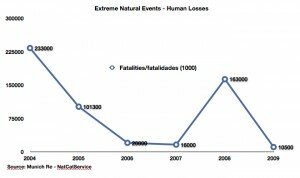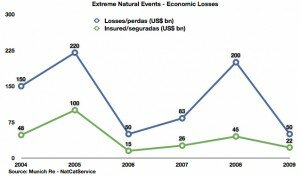Human and economic consequences of extreme natural events
Sergio Abranches
Extreme natural events may be a source of huge human and economic losses, although they are not, in themselves ‘disasters’. A disaster happens when an extreme natural event reaches a populated area.
Often the extent of human losses depends on the vulnerability of the population affected as well as on the degree of preparedness, and the quality of resources for disaster prevention. A poor country will suffer more. The poor wherever they are also will suffer more. Economic losses are greater where there is more property to be damaged, especially valuable economic assets such as industrial plants, commercial buildings, crops or large residential areas.
Munich Re’s NatCatService collects data on fatalities and economic losses caused by ‘natural disasters’ – a misnomer. It shows that, from 2004 to 2009, 543 thousand people have died from natural geophysical, and climatic/hydrological events. Economic losses amounted to US$ 753 billion, and insured losses to US$ 256 billion. Geophysical events are earthquakes and volcanic eruptions. Climatic and hydrological events are storms, floods, landslides, extreme temperatures, droughts, and wildfires.
Losses were caused by a total of 4,725 extreme events. Geophysical events represented, on average, 11% of the total over the last six years. But, they were, on average, the cause of 47% of human losses. There were three major deviations from this average. In 2004, that category of extreme events provoked 95% of total fatalities, because of the earthquake and tsunami in South Asia and East Africa, killing 220 thousand people. In 2004, it represented 90% of fatalities. An earthquake in Pakistan, India and Afghanistan killed 88 thousand people. In 2007, however, geophysical events accounted for only 5% of the fatalities. The deadliest events were cyclone Sidr, killing over 3,775 people in Bangladesh, and floods in China, killing almost 6,800 people.
Climatic and environmental events accounted for 89% of total extreme events registered. Storms were 41% of the total; floods and landslides averaged 31%; waves of extreme temperatures and wildfires, 17%. They were also the main source of economic losses, accounting, on average, in the period, for 81% of such losses. Storms were, by far, the costliest events, explaining around 58% of economic losses. (Click for larger image)

Both human and economic losses vary greatly year by year, depending on the incidence of extreme events in more populated areas. As the chart shows, the greatest fatalities have occurred in 2004, due to the earthquake, particularly the tsunami in South Asia and East Africa. The second deadliest year was 2008 because of the fatalities caused by the earthquake in China, killing more than 70 thousand people, and cyclone Nargis, in Myanmar, killing almost 85 thousand people. (Click for larger image)

Unfortunately, it appears that 2010 will be among the deadliest and costliest of the last seven years.
Isn’t that warning enough? Nature can be deadly and cause huge economic losses. Climate is becoming deadlier and causing great economic losses. We already have plenty of reason to start taking precautionary measures globally. We should be already implementing strong measures to adapt and prepare for more extreme events in the near future, as well as to act to prevent a climatic cataclysm by the second half of this century.
Ambitious targets for reducing greenhouse gases emissions can’t be viewed as measures leading to recessions or economic sacrifice. Extreme natural events are the ones taking lives, destroying property and damaging the economy. The portion that is not climate or environment related, geophysical events, represents a small percentage of total extreme natural events observed. They are mostly unpredictable, and uncontrollable. There is no way to mitigate them, but preparedness can and should be improved.
Extreme climatic and environmental events are almost 90% of total extreme events and they are increasingly more predictable. Although they cannot be controlled, their causes and effects can be mitigated. The rational, and economically sound decision is to prevent, adapt and mitigate. Reasons for climate change policies are concrete, not theoretical, or moral. They make economic sense, they improve human safety and well-being, they save lives.
Tags: AGW, climate, cyclone, earthquake, economy, flood, GHG, hurricane, natural disasters, storm


